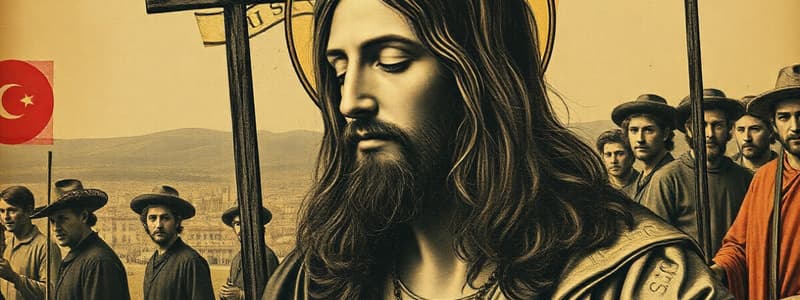Podcast
Questions and Answers
The project of determining what can be said with high probability about Jesus of Nazareth is better named 'the quest of the historian's _____.'
The project of determining what can be said with high probability about Jesus of Nazareth is better named 'the quest of the historian's _____.'
Jesus
The first quest of the historical Jesus was described brilliantly and analyzed critically by _____ Schweitzer.
The first quest of the historical Jesus was described brilliantly and analyzed critically by _____ Schweitzer.
Albert
The methodology used by representatives of the third quest is _____ criticism.
The methodology used by representatives of the third quest is _____ criticism.
historical
One strand of the third quest, represented by the Jesus Seminar, has concentrated on the _____ of Jesus.
One strand of the third quest, represented by the Jesus Seminar, has concentrated on the _____ of Jesus.
The narrower version of historical criticism operates on three principles, one of which is _____ and effect.
The narrower version of historical criticism operates on three principles, one of which is _____ and effect.
Flashcards are hidden until you start studying
Study Notes
Historical-Theological Reading of Jesus of Nazareth
- The "third quest" of the historical Jesus aims to determine what can be said with high probability about Jesus of Nazareth through modern historical research.
- Sobrino's interpretation of Jesus' death focuses on the confrontation between Jesus and Pilate as a choice between the God of Jesus and the God of the Roman Empire, specifically the "pax romana."
- Sobrino believes that Jesus was killed because of his life, teachings and actions, which were viewed as a threat by both Jewish and Roman authorities.
Hermeneutical Perspective
- Sobrino's work is not considered a "narrow historical-critical" reading, but rather a "historical-theological reading."
- His interpretation centers on preunderstanding, fusion of horizons, verification, and appropriation.
Preunderstanding
- Sobrino recognizes the importance of understanding the Bible as a sacred text that transcends its original context, allowing for a deeper encounter with God.
- Sobrino's interpretation is influenced by his Catholic priesthood, Jesuit background, and decades of work in El Salvador.
- He approaches the Gospel passion narratives initially as historical sources, temporarily bracketing explicit theological post-Easter interpretations.
Verification
- Sobrino's interpretation aligns with the "generic appropriateness" of the Gospels as biographical accounts focused on moral meaning and exemplary value, rather than strict chronological accuracy.
- He acknowledges that the Gospels portray Jesus as a target of growing hostility, emphasizing that the passion narratives cannot be understood without considering this context.
- He highlights that Jesus' religious message about God’s kingdom, similar to the ministry of Martin Luther King Jr. was a key factor in his conflict with religious and political authorities.
Appropriation
- Sobrino's historical-theological reading of Jesus' death emphasizes the impact of the text on the reader, involving elements like significance, fusion of horizons, effective history, and appropriation.
- He connects Jesus' death to the suffering servant in Isaiah 53, as a model for both the passion of Jesus and the passion of the marginalized and oppressed throughout history.
- He expands on the concept of martyrdom, not just as dying for Jesus, but also dying like Jesus for his cause, including those who suffer in the name of justice and the kingdom of God.
- Sobrino provides a contemporary understanding of Jesus' death, applying it to the struggles of the "crucified people" of Latin America and beyond.
Studying That Suits You
Use AI to generate personalized quizzes and flashcards to suit your learning preferences.



